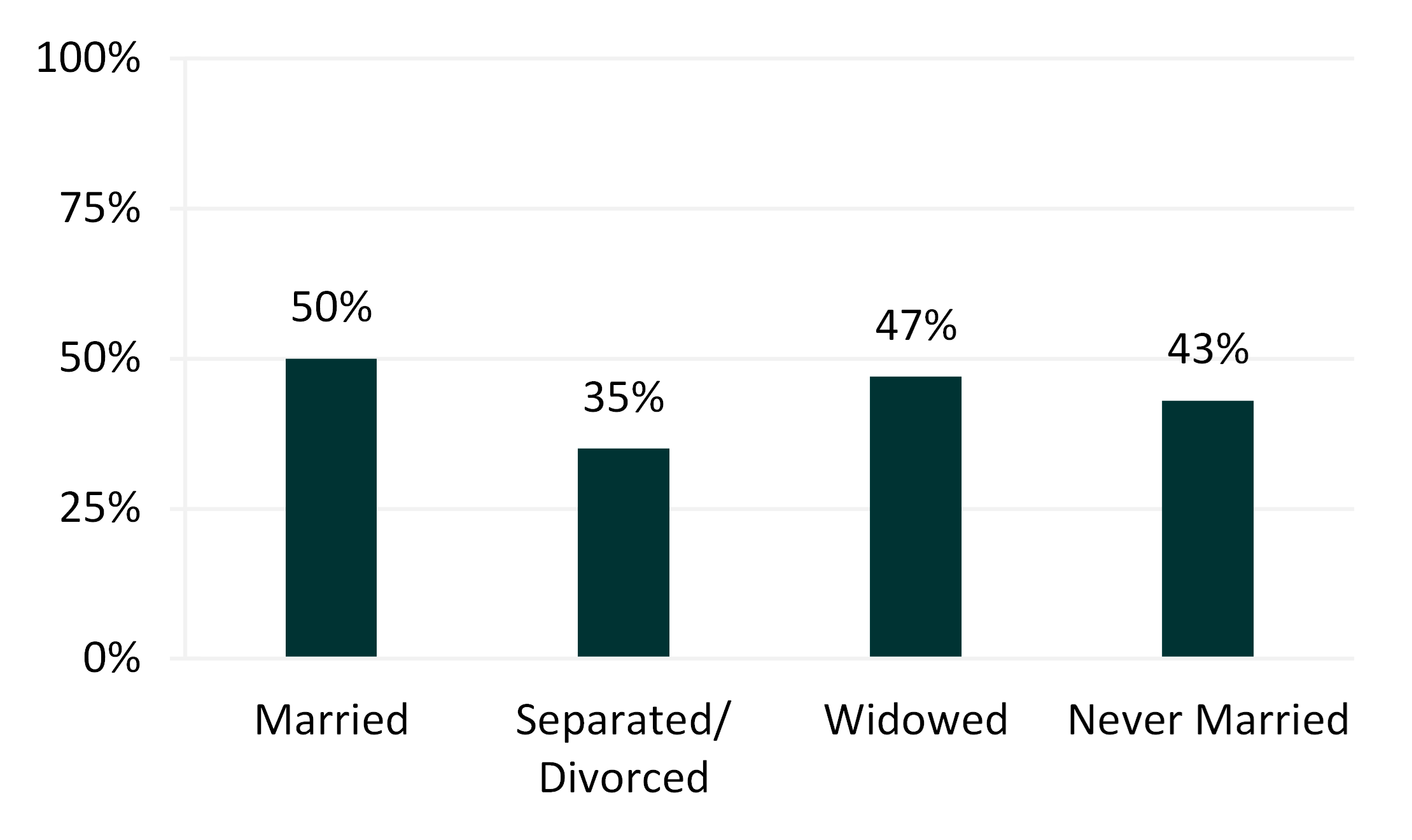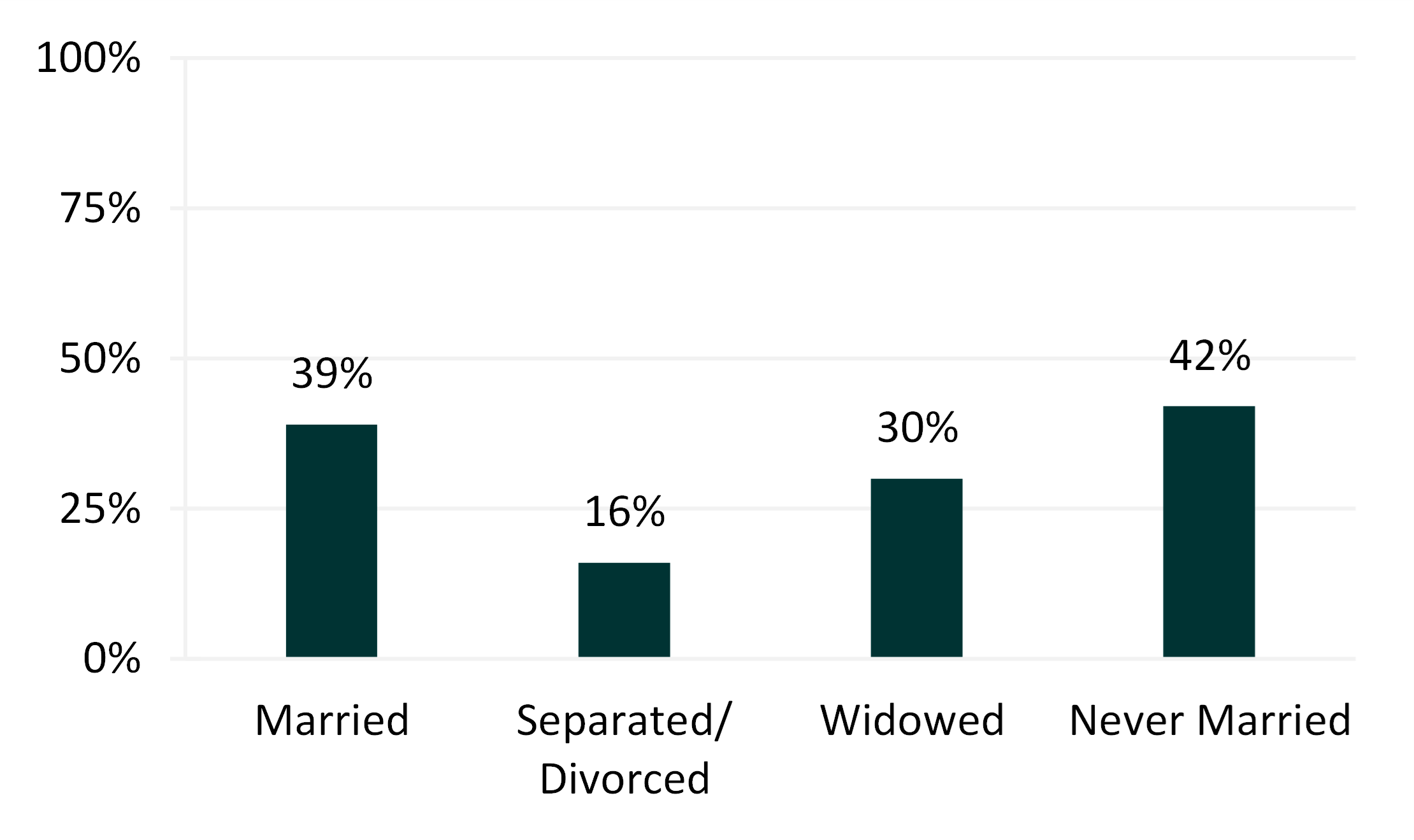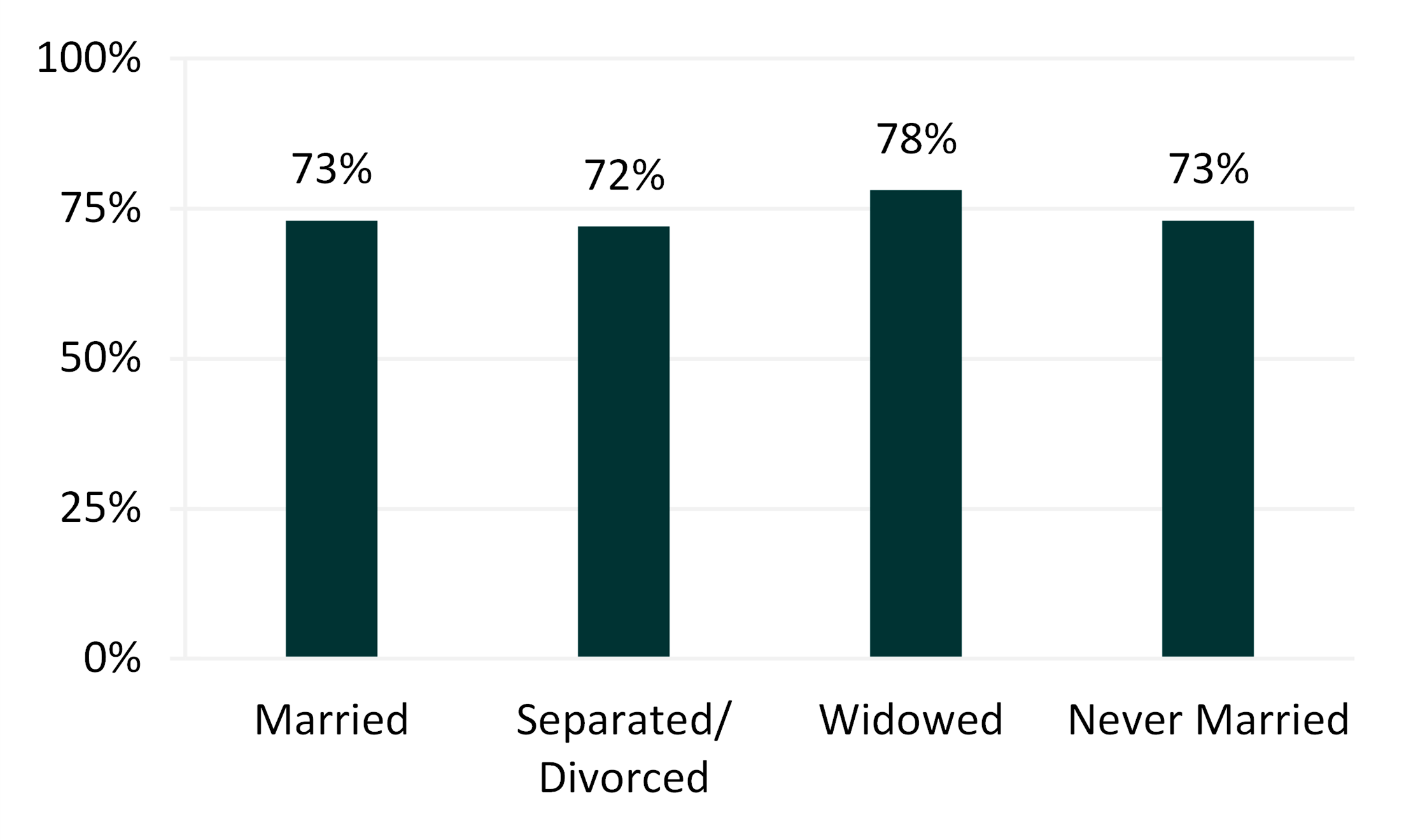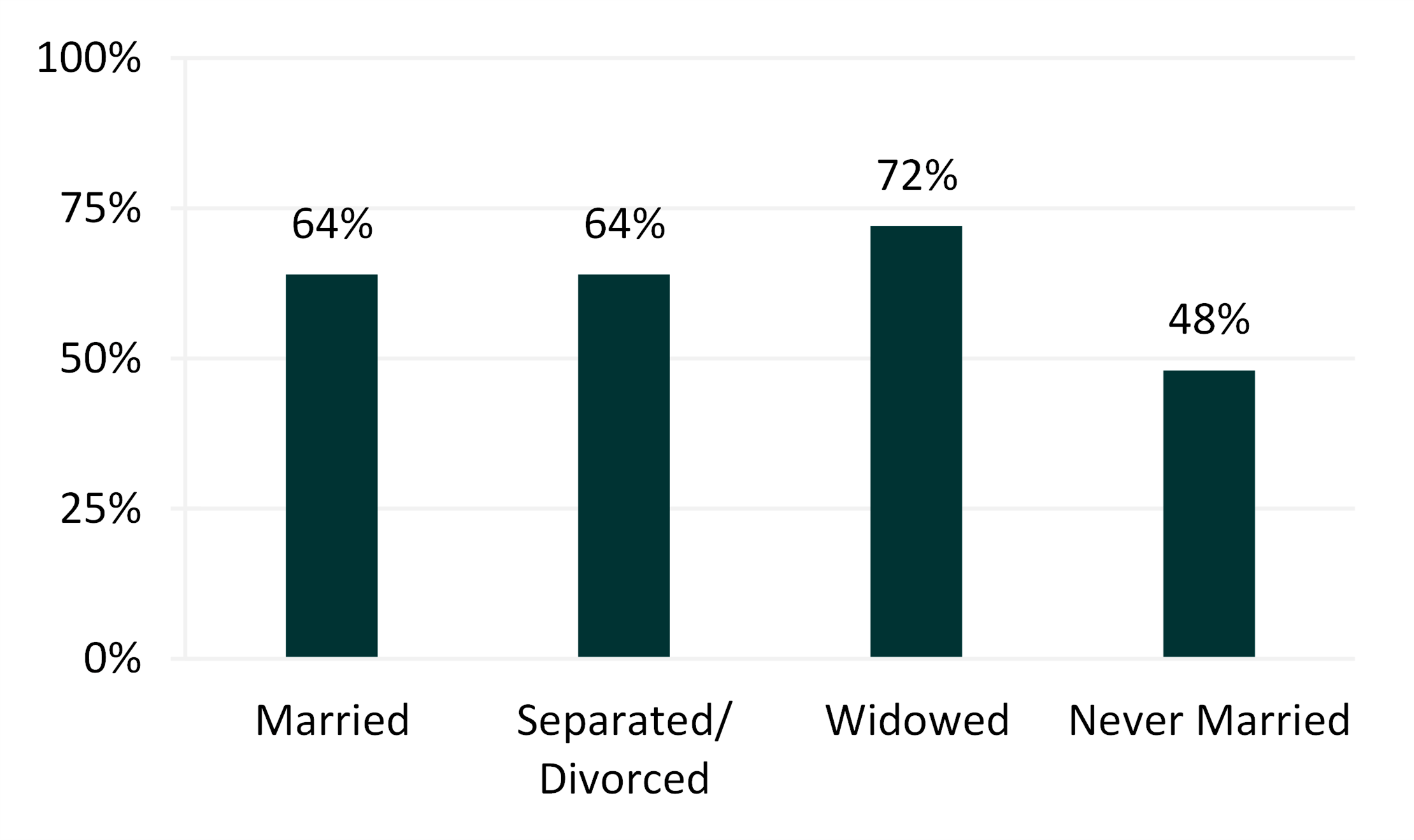Marital Status Variation in Religiosity Among Older Women and Men
Family Profile No. 18, 2022
Authors: Francesca A. Marino & Kagan A. Mellencamp
Religiosity, feelings of closeness to a God, and involvement in religious activities, are linked to higher levels of couples’ commitment to one another and marital quality (Dollahite & Lambert, 2007). In long-term couples they are associated with a reduced likelihood of divorce (Dollahite & Lambert, 2007; Tuttle & Davis, 2015). A growing number of older adults are currently unmarried due to increasing shares experiencing a gray divorce (Brown & Lin, 2022, 2012) or never marrying (Lin & Brown, 2012), demonstrating the need to explore the heterogeneity in church attendance and religious attitudes among the unmarried. Using the 2016 wave of the Health and Retirement Study (HRS), this family profile examines religious service attendance and religious attitudes by marital status among adults aged 65 and older, distinguishing between women and men.
Religious Service Attendance Among Women by Marital Status
- About half of married women aged 65 and older reported they attended religious services at least once a week, a level which exceeded that of all unmarried women.
- Following married women, 47% of widowed women and 43% of never married women report that they attended religious services once or more than once a week.
- Older divorced women reported the lowest frequency of weekly religious service attendance at 35%.
Figure 1. Percentage of Women Aged 65 and Older Who Reported Attending Religious Services Weekly or More Often

Religious Service Attendance Among Men by Marital Status
- Men aged 65 and older tended to have lower weekly religious service attendance than women aged 65 and older across all marital statuses.
- 42% of never married men reported they attended religious services at least once a week, followed by married men (39%) and widowed men (30%).
- Like women, divorced men aged 65 and older had the lowest percentage of weekly religious service attendance (16%), with the level for divorced men roughly half that of divorced women.
Figure 2. Percentage of Men Aged 65 and Older Who Reported Attending Religious Services Weekly or More Often

Religious Beliefs Among Women by Marital Status
- The percentage of older women who somewhat agreed or strongly agreed that they carry their religious beliefs with them daily was higher than the percentage of older women that reported at least weekly religious service attendance across all marital statuses.
- 78% of widowed women aged 65 and older reported they carry their religious beliefs with them daily, followed by married women and never married women (73%).
- In line with religious service attendance, divorced women aged 65 and older (72%) reported lower importance of religious beliefs in their daily lives than women of other marital statuses.
Figure 3. Percentage of Women Aged 65 and Older Who Somewhat Agree or Strongly Agree that They Carry Religious Beliefs with Them Daily

Religious Beliefs Among Men by Marital Status
- Men aged 65 and older tended to report lower importance of religious beliefs in their daily lives than women aged 65 and older across all marital statuses.
- Like women, widowed men aged 65 and older had the highest percentage (72%), followed by married and divorced men (64%).
- Never married men (48%) reported the lowest importance of religious beliefs in their daily lives
Figure 4. Percentage of Men Aged 65 and Older Who Somewhat Agree or Strongly Agree that They Carry Religious Beliefs with Them Daily

Data Sources:
Health and Retirement Study, (RAND HRS Longitudinal File 2018 (V1)) public use dataset. Produced and distributed by the University of Michigan with funding from the National Institute on Aging (grant number NIA U01AG009740). Ann Arbor, MI, (2021).
Health and Retirement Study, (RAND HRS 2016 Fat File (V2B)) public use dataset. Produced and distributed by the University of Michigan with funding from the National Institute on Aging (grant number NIA U01AG009740). Ann Arbor, MI, (2016).
References:
Brown, S. L., & Lin, I.-F. (2022). The Graying of Divorce: A Half Century of Change. The Journals of Gerontology: Series B.
Brown, S. L., & Lin, I.-F. (2012). The gray divorce revolution: Rising divorce among middle-aged and older adults, 1990-2010. The Journals of Gerontology. Series B, Psychological Sciences and Social Sciences, 67(6), 731-741. https://doi.org/10.1093/geronb/gbs089
Dollahite, D. C., & Lambert, N. M. (2007). Forsaking all others: How religious involvement promotes marital fidelity in Christian, Jewish, and Muslim couples. Review of Religious Research, 48(3), 290-307.
Lin, I.-F., & Brown, S. L. (2012). Unmarried boomers confront old age: A national portrait. The Gerontologist, 52(2), 153-165.
Tuttle, J. D., & Davis, S. N. (2015). Religion, infidelity, and divorce: Reexamining the effect of religious behavior on divorce among long-married couples. Journal of Divorce & Remarriage, 56(6), 475-489. https://doi.org/10.1080/10502556.2015.1058660
Suggested Citation:
Marino, F. A. & Mellencamp, K. A. (2022). Marital status variation in religiosity among older women and men. Family Profiles, FP-22-18. Bowling Green, OH: National Center for Family & Marriage Research. https://doi.org/10.25035/ncfmr/fp-22-18

This project is supported with assistance from Bowling Green State University. From 2007 to 2013, support was also provided by the U.S. Department of Health and Human Services, Office of the Assistant Secretary for Planning and Evaluation. The opinions and conclusions expressed herein are solely those of the author(s) and should not be construed as representing the opinions or policy of any agency of the state or federal government.
Updated: 07/25/2022 03:12PM


